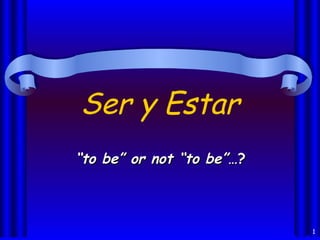
Serestar
- 1. 1 Ser y Estar ““to be” or not “to be”to be” or not “to be”…?…?
- 2. 2 Ser y EstarSer y Estar en español…en español… • Both verbs mean “to be” • Used in very different cases • Irregular conjugations
- 3. 3 ¿Cuáles son las formas?¿Cuáles son las formas? Soy Eres Es Somos Sois Son Estoy Estás Está Estamos Estáis Están SerSer EstarEstar
- 4. 4 Los usos del verbo Ser: • Origin of a person or thing (Él es de Perú) • Identification, who you are • Physical description • Telling time (la hora) and date (la fecha) • Time and place of an event • With the preposition “de” (possession, material)
- 5. 5 Algunos Adjetivos con SER:Algunos Adjetivos con SER: nuevo rojo popular fantástico divertido bueno cariñoso verde simpático alto (unas características)(unas características)
- 6. 6 El OrigenEl Origen:: Juan eses de España. El libro eses de Guatemala. Mis primos sonson de Buenos Aires.
- 7. 7 La IdentificaciónLa Identificación:: Tú ereseres María. Nosotros somossomos hermanos de Paco. El Sr. Ayala eses profesor de español.
- 8. 8 DescriptionDescription:: Yo soysoy muy alto y delgado. Carmen y Pablo sonson jóvenes. Esta clase no eses aburrida.
- 9. 9 La Hora y la fechaLa Hora y la fecha:: ¿Qué hora eses ? SonSon las tres de la tarde. HoyHoy eses el 17 de febrero.
- 10. 10 Un EventoUn Evento:: El partido (game) eses a las ocho. La fiesta eses a las diez. Los conciertos sonson por la noche.
- 11. 11 La preposición “de”La preposición “de”:: Possession: El libro eses de María. Material: El pupitre eses de metal y plástico.
- 12. 12 Los usos del verbo Estar: • Location of a person or thing (la localización) • Adjectives that change • Impressions or opinions (las opiniones)
- 13. 13 Algunos Adjetivos con ESTAR:Algunos Adjetivos con ESTAR: cansado abierto cerrado nervioso enfermo libre contento limpio ocupado sucio (unas condiciones)(unas condiciones)
- 14. 14 La LocalizaciónLa Localización:: Madrid estáestá en España. Mis libros estánestán en mi casa. ¿Dónde estáisestáis vosotros?
- 15. 15 Changing adjectivesChanging adjectives:: La ventana estáestá abierta (opened). Marcos y Elena estánestán nerviosos. Mateo estáestá contento.
- 16. 16 Las OpinionesLas Opiniones:: Tu hermana estáestá guapa hoy. El pescado estáestá muy bueno.
- 17. 17 ¿Cuáles son los usos¿Cuáles son los usos de estos verbos?de estos verbos?
- 18. 18 Los usos del verbo Ser: • OriginOrigin • IdentificationIdentification • DescriptionDescription • Telling timeTelling time • Events takes placeEvents takes place • Possession, materialPossession, material
- 19. 19 Los usos del verbo Estar: • LocationLocation • AdjectivesAdjectives that changethat change • OpinionsOpinions
- 20. 20 ¡Practicamos!¡Practicamos! Mi amigo es / estáes / está de la República Dominicana. Son / EstánSon / Están las diez de la noche. Los libros son / estánson / están de la profesora nueva. El partido de béisbol es / estáes / está a las cuatro hoy. ¿Quiénes son / estánson / están los estudiantes nuevos? Hoy yo soy / estoysoy / estoy muy nervioso.
- 21. 21 ¡Practicamos más!¡Practicamos más! ¿Dónde es / estáes / está el concierto de rock? Carmen y yo somos / estamossomos / estamos muy cansados. Los profesores son / estánson / están apurados. El libro de historia es / estáes / está muy interesante. Mi bisabuela no es / estáes / está muy contenta hoy. Mi madre siempre es / estáes / está ocupada.
- 22. 22 ¡Y más!¡Y más! ¿De quién es / estáes / está el camión? El teatro es / estáes / está cerca de la tienda. Mañana es / estáes / está domingo, ¿verdad?. Margarita es / estáes / está muy triste hoy. La casa nueva es / estáes / está de los García. Juan y tú sois / estáissois / estáis amigos buenos, ¿no?.
- 23. “How you feel and where you are always take the verb ESTAR.”